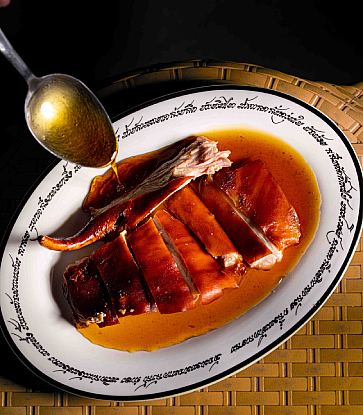Located in the north of Chiang Mai province, Fang shares the border with Chiang Rai Province and Myanmar. Its varied landscape includes peaceful rice paddies, the Fang River Valley, secluded hot springs and steep hillsides, the weather is pleasant year-round, with winters having the possibility of getting quite cold.
Fang is perhaps most famous for Doi Ang Khang (Doi means hill in Thai) with a peak of 1,928 metres above sea level, and home to the Royal Agricultural Project. Established in 1969 by His Majesty King Bhumibol Adulyadej the Great, it was the first of its kind in Thailand. But these peaceful mountains have not always been a tourist destination. In the 1960s, it was notoriously known for the poppy plantations. In hopes of halting the opium production, His Majesty initiated the project to give the local hilltribe farmers a permanent income from the cultivation of agricultural crops. The project was a success, both in terms of providing a livelihood for the locals in the area and in terms of introducing temperate fruits, vegetables and flowers to the region.

The Produce of Doi Ang Khang
Over the years, dozens of species of non-indigenous fruits and vegetables were introduced to Doi Ang Khang. The area served as a testing ground for acclimatising these products before they were distributed to other parts of Thailand.

Situated right at Doi Ang Khang is the Royal Agricultural Station Angkhang. This pristinely kept station was founded in 1969 to research alternative crops to replace the then-thriving opium cottage industry. Cold-weather fruit trees are abundant, and visitors can see planting demonstrations for peaches, plums, strawberries, persimmons and raspberries. The station is also famous for its well-curated bonsai garden and a restaurant that features fresh locally grown produce. The Royal Agricultural Station Angkhang also features accommodation on site and is open from 8:00 - 20:00 hrs. every day.
The First Royal Factory at Fang Museum, located at Ban Yang Village in Mae Ngon Sub-district of Fang District in Chiang Mai Province, is also worth a visit. Established as an educational initiative for the agro-processing industry, it also serves as a display center for products created with produce from the Royal Projects. It is open from Tuesday to Sunday from 8:30 - 16:30 hrs, except on government holidays and the last two weeks of September. There is also a market every Saturday evening and a walking street every Tuesday evening featuring local products.
Visiting Hilltribes
Next, we venture to the Thai-Myanmar border at the Village of Nor Lae, for what many believe to be one of the most dramatic views of Thailand and its neighbouring countries. Situated on Doi Ang Khang, the settlement was established in 1984 by the Palong (or Palaung) people. Having migrated from southern China to Myanmar and now to Thailand, they call themselves the Dara-Ang. The journey to this village will take visitors through winding mountain roads interrupted by herds of grazing cattle and beautiful farm terraces. Everyday life flows as calmly as the mountain breeze. A Thai Army Border Post is located here along with a corresponding Myanmar base across the border. From the village, the hills of Thailand and the valley of Myanmar may be seen.

Ban Khop Dong, and particularly the School of Ban Khop Dong, is known among locals as the one place to best experience the ‘sea of fog.’ This natural phenomenon occurs when mountain air becomes trapped atop tree-carpeted hills and the uneven cooling creates pristine condensation that creates an ocean of white clouds interspersed by islands of grey-green. Even for the seasoned traveller, the sight is something to behold, especially during early morning hours. As the school’s camp ground is currently closed for improvement, we recommend finding accommodation or camping nearby and making this a day trip.
Two tribes share Ban Khop Dong - the Black Lahu (Black Muser) and Red Lahu (Red Muser). Although each tribe has varying religious beliefs, they have coexisted peacefully for generations, insisting on their commitment to upholding the Lahu way of life. While here, visitors may experience Lahu traditional cuisine, known for its use of chilli and salted or preserved food like tofu, meats and pickled vegetables. There is also a strong culture of upholding Lahu hunter-warrior heritage, and it was not that long ago that all Muser men carried a sword on their backs.
A trip along some of the northernmost Thai attractions is open for adventure seekers and travellers focused on sustainable tourism. The journey has hidden gems and enchanting beauty that truly highlight this often-overlooked area.
This article is brought to you by Tourism Authority of Thailand.
To know more about Tourism Authority of Thailand, please visit https://www.tourismthailand.org/
More information:
TOURISM AUTHORITY OF THAILAND, CHIANG MAI OFFICE
105/1 Chiang Mai-Lamphun Road, Tambon Watgate, Amphoe Mueang, Chiang Mai
Tel. +66 (0) 5324 8604-5
Email : tatchmai@tat.or.th
www.tourismthailand.org/chiangmai
Addresses:
First Royal Factory
Ban Yang Village, Moo 12, Mae Ngon Sub-district, Fang District, Chiang Mai Province
Tel. +66 (0) 5305 1021
https://www.facebook.com/pg/firstroyalfactory/
The Royal Agricultural Station Angkhang
1 M.5, Maengon Sub-district, Fang District, Chiang Mai Province 50320
Tel. +66 (0) 5345 0107-9
http://www.royalprojectangkhang.com/

















%20-%20Aman%20Nai%20Lert.jpg)


